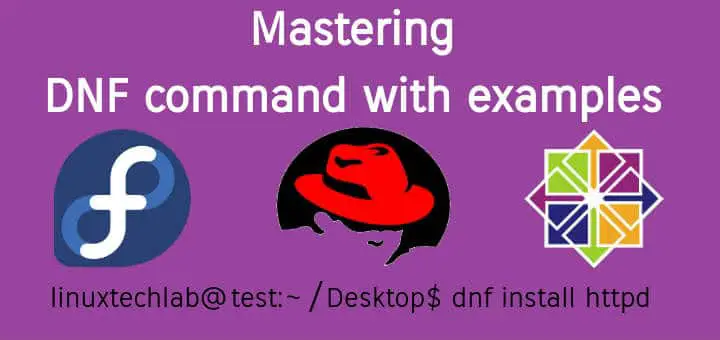DNF was first made available in Fedora 18 & with Fedora 22, it had replaced Yum to become default package manager for handling the system package files. DNF or Dandified YUM is actually a fork of YUM package manager.
The problems like poor performance, high memory usage, slowness for dependency resolution etc, that have been associated with yum, DNF improves on them. In simple terms, it can be said to the future of YUM.
Recommended Read : Working with RPMs: Redhat Package Manager (with examples)
Also Read : Working with YUM command (with examples)
In this tutorial, we will discuss the DNF command with examples, so let’s start,
DNF command with examples
Package installation
To install in DNF, we use the ‘install’ option followed by package name,
$ sudo dnf install package
Package Removal
To remove a package, we can either use ‘remove’ or ‘erase’ option,
$ sudo dnf remove package
$ sudo dnf erase package
Package Update
To update only a single package on the system, execute the following command,
$ sudo dnf update package
Full system update
To check the available updates for all the system packages, we can run the following,
$ sudo dnf check-update
All system packages Upgrade
When all packages installed on the server are to be upgraded, we can use,
$ sudo dnf upgrade
List enabled repositories
To check all the repositories that are currently enabled on the system, we will use
$ sudo dnf repolist
List all repositories
To get the list of all the repos, whether they are enabled or disabled, use the following command,
$ sudo dnf repolist all
Enable repo for installation
To install a package from a particular repository, we need to enable the repo first. We can do this with the following command,
$ sudo dnf --enablerepo=repo-name install package
List all group packages
To get the list of all the group packages available for the system, run the following command
$ sudo dnf grouplist
Group packages Installation
It's similar to installing a single package but we replace the ‘install’ option with ‘groupinstall’,
$ sudo dnf groupinstall ‘group_name’
Group packages removal
To remove a complete group of packages from the system, run the following dnf command,
$ sudo groupremove ‘group_name’
We can also use ‘groupupdate’ for updating the group packages as well.
Re-install a package
If a package requires re-installation, use the following command,
$ sudo dnf reinstall package
Upgrade to a particular version
If required to upgrade to a particular version, we can use the following command,
$ sudo dnf upgrade-to package_version
List all available packages
To get list of all available packages from repositories, open terminal & run
$ sudo dnf list available
List installed packages
To get the list of all installed packages on the system, use the following command,
$ sudo dnf list installed
List all installed & available packages
To print the list of all installed & available packages, use the following command
$ sudo dnf list
Search packages
To look for a particular package from the repositories , execute
$ sudo dnf search package
Download-Only a package
To only download an available package (& not install it), execute the following command,
$ sudo dnf download package
Check package name to get a required functionality
To get the package name for command, we can use option ‘provides’ followed by command name or also we can use a file name in place of command name,
$ sudo dnf provides funtionality_name
$ sudo dnf provides /file_path
For example,
$ sudo dnf provides httpd
$ sudo dnf provides /etc/httpd/conf/httpd.conf
Check package information
To get all details about a package, use the following command,
$ sudo dnf info package
Check the DNF history
To get list of all DNF history i.e. all package installation/removal/updates etc. Run the following command,
$ sudo dnf history
You will than get list of all operations completed with DNF along with number. To get complete details about a particular DNF operation, run
$ sudo dnf history info 13
Synchronize all the packages to latest stable releases
To sync a package to the latest stable release,
$ sudo dnf distro -s sync package
To sync all the packages to latest stable release, use
$ sudo dnf distro-sync
List all options for DNF command
To get a list of all the available options that can be used with DNF, run
$ sudo dnf help
With this end our tutorial on DNF command with examples. Please do leave us any questions or queries you have regarding this article using the comment box below.
If you think we have helped you or just want to support us, please consider these :-
Connect to us: Facebook | Twitter | Google Plus
Donate us some of your hard earned money: [paypal-donation]
Linux TechLab is thankful for your continued support.
